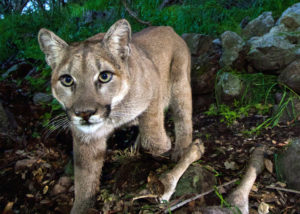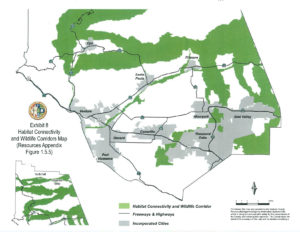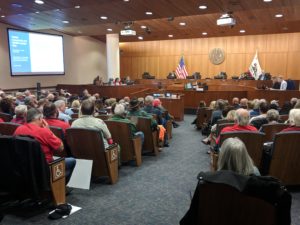After an eleven-hour hearing, the Ventura County Planning Commission voted 5-0 to approve a package of protections for “Habitat Connectivity and Wildlife Corridors,” sending the matter to the Board of Supervisors for final consideration. The new regulations, which would become part of the County’s zoning ordinance, would allow wildlife like mountain lions, black bears, coyotes, badgers, foxes, mule deer, and many other species to travel between the Santa Monica Mountains National Recreation Area and the Los Padres National Forest, and they would also provide protection for the small pockets of habitat found in these important passageways between.
ForestWatch submitted a letter supporting the protection of wildlife corridors, joined by the California Chaparral Institute, Conejo Valley Audubon Society, Defenders of Wildlife, Keep Sespe Wild Committee, Sierra Club – Los Padres Chapter, and Ventura Audubon Society. We also attended yesterday’s hearing to provide testimony urging the Planning Commission to advance to the proposal to the Board of Supervisors. Other groups supporting the proposal included Center for Biological Diversity, Friends of the Santa Clara River, Santa Monica Mountains Conservancy, Citizens for Responsible Oil and Gas, Save Open Space Santa Monica Mountains, Save Open Space and Agricultural Resources, The Nature Conservancy, and Conejo Oak Tree Advocates. Two federal agencies — the National Park Service and the U.S. Fish & Wildlife Service — also supported wildlife corridors, while the cities of Moorpark, Thousand Oaks, and Agoura Hills submitted letters supporting the proposal as well. The City of Moorpark even stated that they would develop similar protections within city limits if the county’s proposal was approved.

Mountain lions like the one pictured here in the Santa Monica Mountains will greatly benefit from the proposed wildlife corridor protections. Photo courtesy National Park Service.
The process began in 2017 when the Board of Supervisors directed its planning staff to develop an ordinance that would protect wildlife corridors throughout the county. Over the course of nearly two years, county planners worked with scientists, federal agencies, landowners, and conservation organizations — including ForestWatch — to create an ordinance that protects wildlife moving through the county from the impacts of new developments and other land uses. The protections would also lay the groundwork needed to make future wildlife crossings along major roadways effective.
“These wildlife corridor protections are a critical first step in ensuring the long-term viability of the wildlife that not only call Ventura County home but define its rugged character and rich natural history,” said ForestWatch Conservation Director Bryant Baker. “This proposed ordinance will ensure that current and future generations will be able to enjoy, admire, and benefit from healthy wildlife populations and properly-functioning ecosystems throughout our region.”
The draft ordinance presented at yesterday’s Planning Commission hearing includes restrictions on outdoor night lighting that negatively impact wildlife, fencing that prevents animal movement, and development near streams that serve as key migration corridors for wildlife. Many exemptions for agricultural activities and other landowners were built into the ordinance, providing significant flexibility for compliance.

Some of the proposed corridors can be seen in this map produced by the County. Explore an interactive map here.
Yesterday’s hearing was heavily attended by developers, oil industry lobbyists, ranchers, and various wildlife opponents who disagreed with the ordinance. One landowner, after shouting that the county planners and commissioners should be “taken out and shot,” was removed from the hearing room by Sheriff’s deputies. Much of the opposition was based on misinformation about how the ordinance would impact individual landowners — most of these misconceptions were addressed numerous times by county staff, the fire department, and wildlife biologists throughout the hearing.
Some landowners believed the ordinance would prevent them from establishing and maintaining defensible space around structures. However, the ordinance language specifically allows broad exemptions for vegetation modification related to fire risk reduction — a point that was confirmed by the Ventura County Fire Protection District at the hearing and in writing.
We should note that countless peer-reviewed scientific publications have demonstrated that vegetation removal far from a structure doesn’t decrease its chances of igniting during a wildfire and that doing so can spread non-native grasses and weeds that worsen fire conditions. In addition to defensible space, scientists have long-stated that the most effective measures for protecting communities from wildfire include reducing development in fire-prone areas, retrofitting existing homes with fire-safe materials, and preventing human-caused ignitions. You can read more about these issues on our fire page.
After hours of public comment and subsequent deliberation, the Planning Commission voted unanimously to send the proposal to the Board of Supervisors with recommendations that certain aspects of the ordinance be changed or examined more closely. You can explore an interactive map of the proposed corridors and existing wildlife crossings here.
The draft ordinance is currently scheduled to go before the Board on Tuesday, March 12. ForestWatch will continue advocating for increased protections for wildlife and their habitat in Ventura County to ensure that they have room to roam across this increasingly fragmented landscape.








Comments are closed.